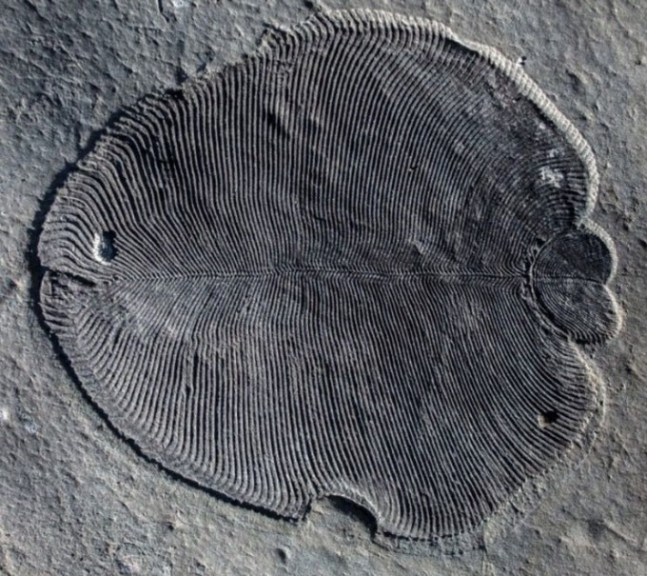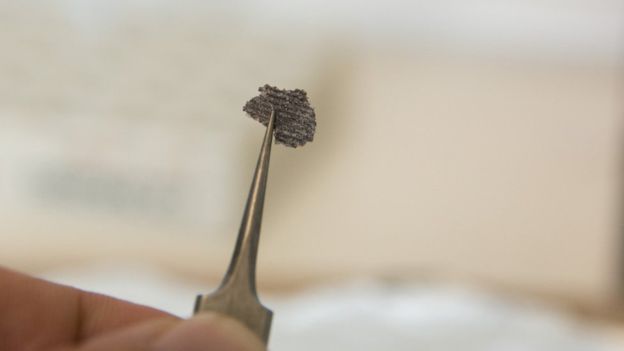(원문)
Fossils of ancient sea creatures answer a long-standing question about how animals became bigger and more complex.
The strange sea creatures known as Dickinsonia, shown here in fossil form, lived 558 million years ago.
Fossil imprints that resemble the rippled underside of a mushroom’s cap are remnants of the oldest-known animals in Earth’s history. The finding, published in Science on 20 September1, is based on a chemical analysis of fatty molecules preserved in the fossils. It could alter the current story of how animals and other complex life arose.
Researchers first discovered the pancake-shaped creatures — a group known as Dickinsonia — in the late 1940s. The species were among the most common residents of the world’s oceans 558 million years ago, during the Ediacaran period. Whereas most living things during that time ranged in size from microscopic to a few millimetres long, some Dickinsonia grew up to 1.4 metres in length.
The creatures’ large size has puzzled scientists because Dickinsonialived tens of millions of years before the Cambrian explosion, the period 541 million years ago when living things became bigger and most major animal groups emerged. Scientists have since debated whether Dickinsonia were primitive animals, giant single-celled organisms called protists, bacterial colonies or something else entirely.
The latest study attempts to end that debate by analysing chemical biomarkers preserved in a unique set of Dickinsonia fossils from Russia, rather than by examining the ancient species’ body characteristics.
Fossil fats
A team led by Jochen Brocks, a palaeobiogeochemist at the Australian National University in Canberra, examined ring-like fat molecules called sterols that infiltrate the membrane surrounding a cell to keep it flexible and fluid. Plants, animals, fungi and bacteria all contain sterols, but the type of sterol that predominates in each group differs. Animals mainly make cholesterol, and the fungi that form colourful, crusty lichens found on boulders have only ergosterol. Under the right conditions, these chemicals can persist for millions of years, and so help to determine a fossilized organism’s evolutionary relationships.
Fossils that contain these preserved biomarkers are rare, but strewn around the shores of the White Sea in northwestern Russia lie Ediacaran fossils — including Dickinsonia — embedded in a fossilized mat of algae, with their organic matter and fats perfectly preserved. “They are, in principle, mummified dickinsonians,” Brocks says. “It’s just incredibly lucky.”
But the team’s analysis revealed dramatic differences in the composition of the biomarker samples. Whereas the surrounding rocks and algal mats contained only about 10% cholesterol and 75% of another sterol that is common in green algae, the Dickinsonia fossils contained 93% cholesterol — suggesting that they were ancient animals living 17 million years before the Cambrian explosion.
The technique provides an entirely different way of determining Dickinsonia’s place on the evolutionary tree, says Guy Narbonne, a palaeobiologist at Queen’s University in Kingston, Canada. “I think it’s quite imaginative.” The findings from the chemical analysis reinforce other evidence that Dickinsonia were primitive animals, he says. This includes fossil ‘footprints’ that show the organisms moved from place to place for food, and growth patterns that match those of most animals today.
The latest findings also suggest that the transition between the Cambrian and the Precambrian, which includes the Ediacaran, was just another extinction event in which one animal community replaced another, Brocks says. “But now the jury’s out on all the other weirdos.”
Analyses that have compared the DNA of living creatures today to trace back their evolutionary trees suggest that animals originated more than 100 million years before the Cambrian — well before even Dickinsonia2. But finding the fossils of these creatures, and then proving they are animals, remains challenging.
Rangeomorphs, strange Ediacaran frond-like creatures with tubes branching in a fractal pattern, for example, remain a mysterious group whose relation to any living organisms is uncertain. “This would be for us the next big challenge,” Brocks says. “Trying to get hold of those strange creatures and find out what they were.”
http://dongascience.donga.com/news/view/24057
역대 가장 오래된 다세포 동물 화석 발견
다세포 동물 출현, 기존 예상보다 최소 1600만 년 앞서
“디킨소니아는 동물?” 70여 년 학계 논쟁에도 종지부

현재까지 발견된 동물화석 중 가장 오래된 5억5800만 년 전 디킨소니아의 화석. 삼엽충과 비슷한 형태의 이 생물은 지구에 등장한 최초의 다세포 동물로 확인됐다. – 국립호주대 제공
5억5800만 년 전에 살았던 다세포 동물의 화석이 발견됐다. 지금까지 발견된 다세포 동물 화석 중 가장 오래됐다. 이로써 다세포 동물의 출현 시기는 기존 예상보다 수천 만 년 이상 앞당겨졌다.
조첸 브록스 국립호주대 교수팀이 이끈 국제 공동 연구진은 러시아 북서부 백해(白海) 인근 절벽에서 5억5800만 년 전 생물의 화석을 발견하고, 함께 보존돼 있던 세포 조직에서 동물성 지방인 콜레스테롤 성분을 검출했다고 국제학술지 ‘사이언스’ 21일자에 발표했다.
콜레스테롤은 동물세포의 세포막을 구성하는 기본 물질로 동물만 가진 성분이다. 길이 1.4m, 삼엽충을 닮은 화석 속 생물은 선(先)캄브리아기 에디아카라 생물군의 일종인 ‘디킨소니아’로 확인됐다. 디킨소니아가 동물이라는 점을 뒷받침하는 직접적인 증거를 찾은 것은 이번이 처음이다.

5억5800만 년 전 디킨소니아(에디아카라 생물군의 일종) 화석에 보존돼 있던 세포 조직. 동물성 지방인 콜레스테롤 성분이 검출돼 디킨소니아가 동물이라는 점이 처음 입증됐다. – 국립호주대 제공
지난 70여 년간 다세포 생물인 디킨소니아를 비롯한 에디아카라 생물군의 정체는 불분명했다. 형태학적 분석에 의존했던 만큼 학자마다 견해가 달랐다. 동물로 분류되기도 하고 동물과 식물의 중간체로 분류되기도 했다. 하지만 이번 발견으로 학계는 이들의 정체를 둘러싼 오랜 논쟁에 종지부를 찍게 됐다.
동시에 에디아카라 생물군이 지구에 출현한 최초의 다세포 동물이라는 사실도 입증됐다. 이전까지는 다세포 동물이 다양한 종류의 동물이 화석으로 발굴된 캄브리아기(약 5억4200만 년 전~4억8800만 년 전)에 처음 지구에 등장했을 것으로 봤다. 캄브리아기 동물의 화석이 대거 발견된 사건을 ‘캄브리아기 대폭발’이라고 한다.
하지만 동물로 확인된 디킨소니아가 이보다 최소 1600만 년 앞선 5억5800만 년의 것으로 밝혀지면서 기존 이론도 흔들리게 됐다. 브록스 교수는 “캄브리아기 이전에도 이미 다양한 동물들이 존재했다는 점을 방증하는 결과”라고 밝혔다.
Ancient steroids establish the Ediacaran fossil Dickinsoniaas one of the earliest animals
Science 21 Sep 2018:
Vol. 361, Issue 6408, pp. 1246-1249
DOI: 10.1126/science.aat7228
여기를 클릭하세요~
Confirming the identity of early animals
The first complex organisms emerged during the Ediacaran period, around 600 million years ago. The taxonomic affiliation of many of these organisms has been difficult to discern. Fossils of Dickinsonia, bilaterally symmetrical oval organisms, have been particularly difficult to classify. Bobrovskiy et al. conducted an analysis using lipid biomarkers obtained from Dickinsonia fossils and found that the fossils contained almost exclusively cholesteroids, a marker found only in animals (see the Perspective by Summons and Erwin). Thus, Dickinsonia were basal animals. This supports the idea that the Ediacaran biota may have been a precursor to the explosion of animal forms later observed in the Cambrian, about 500 million years ago.
Abstract
The enigmatic Ediacara biota (571 million to 541 million years ago) represents the first macroscopic complex organisms in the geological record and may hold the key to our understanding of the origin of animals. Ediacaran macrofossils are as “strange as life on another planet” and have evaded taxonomic classification, with interpretations ranging from marine animals or giant single-celled protists to terrestrial lichens. Here, we show that lipid biomarkers extracted from organically preserved Ediacaran macrofossils unambiguously clarify their phylogeny. Dickinsonia and its relatives solely produced cholesteroids, a hallmark of animals. Our results make these iconic members of the Ediacara biota the oldest confirmed macroscopic animals in the rock record, indicating that the appearance of the Ediacara biota was indeed a prelude to the Cambrian explosion of animal life.
